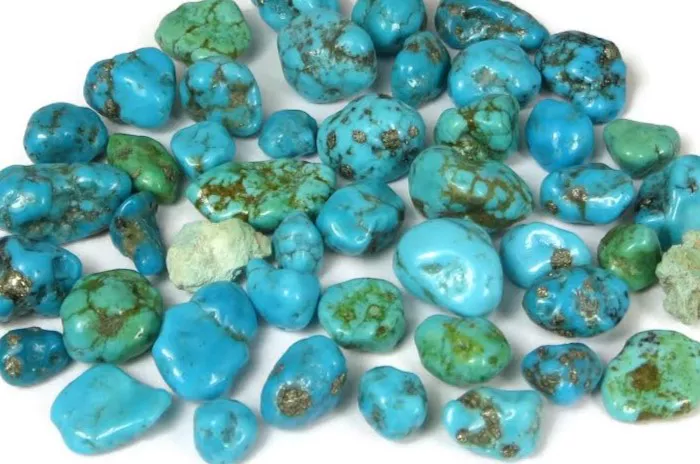Turquoise is a stunning gemstone with a rich history and vibrant color. Its price varies widely depending on quality, origin, and market demand. If you’re wondering, “How much does turquoise cost per gram?” this guide will explain everything you need to know. We will discuss factors affecting turquoise prices, different types of turquoise, and how to determine its value.
Understanding Turquoise Pricing
Turquoise is not sold by weight alone, unlike gold or silver. However, knowing its price per gram helps compare different pieces. On average, natural turquoise costs between 1to100 per gram, depending on quality. Some rare, high-grade turquoise can exceed this range.
Why Does Turquoise Price Vary So Much?
Several factors influence turquoise pricing:
Quality of the Stone – High-quality turquoise has a rich, even color and minimal impurities.
Origin – Some mines produce more valuable turquoise than others.
Treatments – Natural, untreated turquoise is more expensive than stabilized or dyed turquoise.
Size and Cut – Larger, well-cut stones cost more per gram than small or irregular pieces.
Market Demand – Popular colors and styles can drive prices up.
Now, let’s explore these factors in detail.
Quality of Turquoise: The Biggest Price Factor
The quality of turquoise affects its price the most. Here’s how different grades compare:
High-Grade Turquoise (50–100+ per gram)
Color:Deep, uniform blue or blue-green with no fading.
Texture:Smooth, hard, and free from cracks.
Matrix (Veining):Minimal or attractive spiderweb patterns.
Examples: Persian turquoise, Sleeping Beauty turquoise.
Medium-Grade Turquoise (10–50 per gram)
Color: Slightly uneven, may have light green or white areas.
Texture: Some visible pores or minor cracks.
Matrix:More noticeable veining, but still attractive.
Examples:Chinese turquoise, some American mined turquoise.
Low-Grade Turquoise (1–10 per gram)
Color: Pale, blotchy, or heavily veined.
Texture: Soft, porous, or treated to improve durability.
Matrix: Thick, dark veins that dominate the stone.
Examples: Reconstituted or dyed turquoise.
Origin: Where the Turquoise Comes From Matters
Some turquoise mines produce higher-quality stones, increasing their value.
Most Expensive Turquoise (Over $100 per gram)
Persian (Iranian) Turquoise: Known for its pure robin’s egg blue color.
Sleeping Beauty Turquoise (Arizona, USA): Bright sky-blue with no matrix.
Mid-Range Turquoise (20–80 per gram)
Kingman Turquoise (Arizona, USA): Blue with black spiderweb matrix.
Bisbee Turquoise (Arizona, USA): Deep blue with red or brown matrix.
Lander Blue Turquoise (Nevada, USA): Rare and highly collectible.
Affordable Turquoise (1–20 per gram)
Chinese Turquoise: Often dyed or stabilized, but some natural pieces exist.
Mexican Turquoise: Greenish-blue, sometimes porous.
African Turquoise: Lower-grade, often treated.
Natural vs. Treated Turquoise: How Treatments Affect Price
Many turquoise stones are treated to improve their appearance and durability.
Natural Turquoise (Most Expensive)
No treatments – Pure, unaltered stone.
Price: 50–300+ per gram for top-quality pieces.
Stabilized Turquoise (Mid-Range Price)
Treated with resin to harden the stone.
Price: 10–50 per gram.
Dyed or Reconstituted Turquoise (Cheapest)
Lower-quality turquoise dyed to enhance color.
Price: 1–10 per gram.
Size and Cut: How Shape Affects Price
Larger, well-cut turquoise stones cost more per gram because they are rarer.
Cabochons (Domed Cut): Most common, priced by size and quality.
Beads: Small beads are cheaper, but high-grade beads can be expensive.
Carved Turquoise: Intricate carvings increase value.
Rough Turquoise: Uncut pieces are cheaper but require expert cutting.
Market Demand: Trends Influence Prices
Turquoise prices fluctuate based on trends:
Vintage Turquoise Jewelry: Antique pieces can be very expensive.
Southwestern & Native American Styles: Highly sought after.
Fashion Trends: Celebrities wearing turquoise can drive prices up.
How to Determine If You’re Paying a Fair Price
To avoid overpaying, follow these tips:
Check the Color – Rich, even blue or green is best.
Look for Natural Patterns – Spiderweb matrix is desirable.
Ask About Treatments – Natural turquoise costs more.
Compare Prices – Research similar stones before buying.
Buy from Reputable Sellers – Avoid fake or mislabeled turquoise.
Conclusion
Turquoise prices vary widely, from 1toover100 per gram, depending on quality, origin, and treatments. High-grade Persian or Sleeping Beauty turquoise is the most valuable, while dyed or stabilized turquoise is more affordable.
If you love turquoise, investing in a high-quality piece ensures lasting beauty and value. Always buy from trusted sources and understand what you’re paying for. Whether you’re a collector or a jewelry lover, knowing turquoise pricing helps you make smart purchases.
Would you pay top dollar for rare turquoise, or do you prefer budget-friendly options? The choice depends on your taste and budget!
Related topics:
How Much Is Turquoise Worth Per Carat? (Revealed!)
How Much Is Turquoise Worth Per Gram? A Complete Guide
What Is the Highest Grade of Turquoise?


